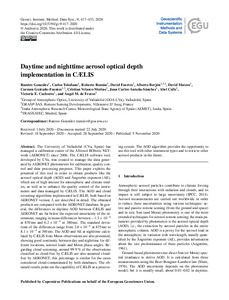Por favor, use este identificador para citar o enlazar este ítem:
http://hdl.handle.net/20.500.11765/12313
Daytime and nighttime aerosol optical depth implementation in CÆLIS
| Título : | Daytime and nighttime aerosol optical depth implementation in CÆLIS |
| Autor : | González, Ramiro; Toledano, Carlos; Román, Roberto; Fuertes Marrón, David; Berjón, Alberto

|
| Palabras clave : | AERONET; Photometers; Aerosol optical depth; Atmospheric aerosol particles |
| Fecha de publicación : | 2020 |
| Editor: | European Geosciences Union |
| Citación : | Geoscientific Instrumentation, Methods and Data Systems. 2020, 9(2), p. 417–433 |
| Versión del editor: | https://dx.doi.org/10.5194/gi-9-417-2020 |
| Resumen : | The University of Valladolid (UVa, Spain) has managed a calibration center of the AErosol RObotic NETwork (AERONET) since 2006. The CÆLIS software tool, developed by UVa, was created to manage the data generated by AERONET photometers for calibration, quality control and data processing purposes. This paper exploits the potential of this tool in order to obtain products like the aerosol optical depth (AOD) and Ångström exponent (AE), which are of high interest for atmospheric and climate studies, as well as to enhance the quality control of the instruments and data managed by CÆLIS. The AOD and cloud screening algorithms implemented in CÆLIS, both based on AERONET version 3, are described in detail. The obtained products are compared with the AERONET database. In general, the differences in daytime AOD between CÆLIS and AERONET are far below the expected uncertainty of the instrument, ranging in mean differences between −1.3×10−4 at 870 nm and 6.2×10−4 at 380 nm. The standard deviations of the differences range from 2.8×10−4 at 675 nm to 8.1×10−4 at 340 nm. The AOD and AE at nighttime calculated by CÆLIS from Moon observations are also presented, showing good continuity between day and nighttime for different locations, aerosol loads and Moon phase angles. Regarding cloud screening, around 99.9 % of the observations classified as cloud-free by CÆLIS are also assumed cloud-free by AERONET; this percentage is similar for the cases considered cloud-contaminated by both databases. The obtained results point out the capability of CÆLIS as a processing system. The AOD algorithm provides the opportunity to use this tool with other instrument types and to retrieve other aerosol products in the future. This research has been supported by the Spanish Ministry of Science and Innovation (grant no. RTI2018-097864-B-I00) and the European Union's Horizon 2020 research and innovation program (grant no. 871115). |
| Patrocinador: | The authors gratefully thank AERONET and PHOTONS teams for the collaboration and support. The authors thank the Spanish Ministry of Science, Innovation and Universities for the support through the ePOLAAR project (RTI2018-097864-B-I00). This research has been supported by the Spanish Ministry of Science and Innovation (grant no. RTI2018-097864-B-I00) and the European Union's Horizon 2020 research and innovation program (grant no. 871115). |
| URI : | http://hdl.handle.net/20.500.11765/12313 |
| ISSN : | 2193-0856 2193-0864 |
| Colecciones: | Artículos científicos 2019-2022 |
Ficheros en este ítem:
| Fichero | Descripción | Tamaño | Formato | ||
|---|---|---|---|---|---|
| gi-9-417-2020.pdf | 2,68 MB | Adobe PDF |  Visualizar/Abrir |
Los ítems de Arcimis están protegidos por una Licencia Creative Commons, salvo que se indique lo contrario.





